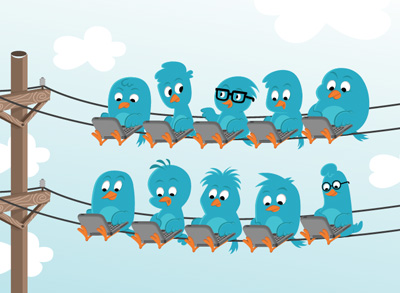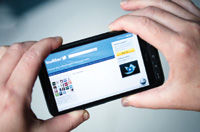
Tweet, tweet!
June 22, 2011
By Michelle Brisebois
We all know the virtues of word of mouth but how’s your word of mouse?
Welcome to web 2.0. We used to surf to gather information; now we surf
to gather friends and interact with those friends and brands that
interest us the most. The bakery industry stands to truly benefit by
leveraging some of these tools, yet many of us struggle with the
learning curve associated with a new technology.

|
We all know the virtues of word of mouth but how’s your word of mouse? Welcome to web 2.0. We used to surf to gather information; now we surf to gather friends and interact with those friends and brands that interest us the most. The bakery industry stands to truly benefit by leveraging some of these tools, yet many of us struggle with the learning curve associated with a new technology. Who has the time in the midst of running a demanding business? Smart brands use Twitter in meaningful ways, and most of them use their brand name as a way to make sure customers can find and recognize them. The big brands like Ford and Martha Stewart consider Twitter a key tool for connecting with customers. Stewart recently told The Daily Beast: “I just love it [Twitter] so much more than Facebook … First of all, you don’t have to spend any time on it, and, second of all, you reach a lot more people. And I don’t have to ‘befriend’ and do all that other dippy stuff that they do on Facebook.”
Not everyone would agree with Stewart’s assessment of Facebook. It does have its place. Facebook is about intimate connections and sharing multimedia with a group of friends. Twitter is about broadcasting and spreading your message to the entire world. As Alicia Whalen of A Couple of Chicks digital marketing puts it: “Twitter is the new comment card. It’s about forming connections with people you don’t necessarily know in person.” If one were to sum up the essence of Twitter’s appeal, the headline might read “Big reach with little effort.”
It’s hard to believe that the first Tweet was sent as recently as March 21, 2006, by co-founder Jack Dorsey. He announced he was setting up Twitter. HARP Social reports that as of April 2011, there were 280 million people on Twitter generating a total of 95 million Tweets a day. New users are signing up to the tune of 460,000 per day! HARP also reports that 53 per cent of people on Twitter recommend companies or products in their Tweets. Twitter only allows the user to make their statement in 140 characters so it forces the marketer to pick a point and make it clearly. For those who argue that Twitter is only for people under the age of thirty, think again. Social Marketing Forum reports that some of the most impressive growth has been in the 55 plus market. Over 40 per cent of people aged 55 and up who are social networkers have been registered on sites for less than two years, suggesting that the baby boomers are just now embracing the channel en masse. Twitter’s speedy growth caused quite a stir and fodder for late night comedians, dismissed as high-tech trivia or the latest in time-wasting devices. But its use in Iran in the wake of the disputed presidential election of June 2009 to organize protests and disseminate information in the face of a news media crackdown made the world suddenly realize its power to crowd source and influence popular opinion. During the Iranian protests, U.S. officials e-mailed Twitter asking that they delay scheduled maintenance of its global network. This maintenance would have cut off service while Iranians were relying on Twitter to communicate with each other and with the outside world about the mushrooming protests around Tehran. Twitter briefly postponed its upgrade. This incident is a prime example of the extent to which the Obama administration regards social networking as an effective form of e-diplomacy in regions where freedom of the press is curtailed. So if Twitter is so powerful, how does a small business jump in and grab its share of the conversation?
 |
|
| Twitter now boasts more than 280 million users from around the world.
|
Tweeting 140
First, decide who will be the resident Tweeter in your bakery. It needs to be someone who’s there regularly, knows many facets of the business, and is outgoing, communicative and comfortable with technology. Whalen suggests choosing someone who won’t come and go and can be a consistent voice with a tone that’s unique to your business. Next, arm that person with the tools they need to create content. A computer or smartphone is ideal so they can Tweet and take pictures as the cakes are being decorated or when muffins come out of the oven. If you, as the business owner, are keen to be the “chief Tweeter” that’s optimal but often a challenge due to time constraints. An eager key holder or senior team member is great as well and may be a better choice if they can give it the focus it needs. Next, integrate your Twitter presence with your website, Facebook page and all marketing materials. Stickers for your packaging that say “Follow us on Twitter” (insert your Twitter address) will help you develop your list of followers.
Content for your Tweets can run the gamut of topics. Do you need to hire staff? Send out a Tweet that says so. Announce a new pie or trumpet the fact that blueberries are in season. Tweet when the bread comes out of the oven or when you’ve created an amazing wedding cake. Take a picture and post a Tweet with the image attached. One of your followers could either be in the market for a wedding cake or know someone who is. What’s really great about Twitter is that if people see something they want to share, they simply hit the Retweet button and it’s broadcasted to all their followers. If that picture of your cake is a showstopper, chances are someone won’t be able to resist Retweeting it with a “look at this” comment attached.
Twitter also allows customers to send us direct messages. By setting up a search function for your business name, you can see if anyone out there is complaining about you. Many companies are terrified of negative comments but it’s better to know about them and respond than stick your head in the sand and let the critic have the last word. If you see a negative comment, offer to assist the customer in resolving their issue. Your followers will give you full marks for being a class act and it will go a long way towards building brand equity.
Above all, Whalen recommends businesses give themselves time to build a following.
“Be authentic, show some personality, don’t sell and make sure to drive traffic back to your transaction point [a website, a phone number or an address]. Use Twitter as part of your overall communications efforts and have fun. It’s social media after all!”
Michelle Brisebois is a marketing professional with experience in the food, pharmaceutical, financial services and wine industries. She specializes in retail brand strategies.
Print this page
Leave a Reply